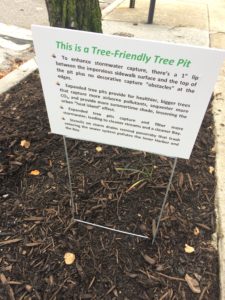What’s a Tree Pit? An Opportunity, I Submit.
 For nearly 9 months of this year, I and some others have been engaged in an effort to reduce impervious surfacing at my very urban Baltimore City church.
For nearly 9 months of this year, I and some others have been engaged in an effort to reduce impervious surfacing at my very urban Baltimore City church.
As the church has no vacant land and city regulations prohibit removing existing concrete surfacing anywhere within 6’ of a building foundation, the only remaining prospect for supporting the city’s TMDL* Watershed Improvement Plan requirement is one where tree pit expansions enable more polluted rainwater to be captured and filtered in the pits so less running directly off sidewalks and streets into an old, overtaxed municipal sewer system that periodically disgorges harmful stuff into tributaries to the Inner Harbor.
As important, trees should become healthier and even bigger through increased watering and more exposure of their root structure to light and air.
So, good enough. Much better than nothing.
Healthier, bigger trees do a number of things, including: sequester more C02; lessen the urban “heat island effect”; lower summer temperatures and air conditioning need; capture airborne particulates; and, help reduce hillside and stream bed erosion.
From treepeople.org’s top 22 benefits comes another, the assertion that: “Trees reduce violence. Neighborhoods and homes that are barren have shown to have a greater incidence of violence in and out of the home than their greener counterparts. Trees and landscaping help to reduce the level of fear.” Who knew? But, makes sense, right?
Here’s a homemade movie (a .wmv file) which showcases how foundation grant money supported multiple, gainful purposes in my church’s tree pit expansion project that added an average of 36% more pervious surface in the existing pits. It stars about 30 elementary and middle school students and their teachers from 3 neighborhood public schools–the all-important hands-on green education component of the grant request and community application. And a few organizers/helpers.
The students were provided cotton garden gloves to use and keep, topsoil, LeafGro and mulch, liriope spicata to plant, and earthworms to place into the reconditioned tree pit soil. The library of each of the 3 schools received an age-appropriate book about caring for the environment. Tree pit signage was designed and fabricated for the project.
.
* TMDL: Total Minimum Daily Load Waste Load Allocations (WLAs) approved by the U.S. EPA